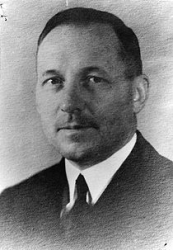
Mervyn Sharp Bennion was born on May 5, 1887, in Vernon, Utah a small farming community in Tooele County about 60 miles southwest of Salt Lake City. His family had a long history as devout members of the Church of Jesus Christ of Latter-day Saints (LDS). His grandfather, John Bennion, was from Wales, joined the church in Liverpool, came to America, and trekked to Utah with the LDS pioneers in 1847. He, the son of Israel and Jeannette Sharp Bennion, grew up on a cattle ranch in rural Utah. CAPT Bennion passed his entrance exams for the Naval Academy earned and an appointment to the US Naval Academy at Annapolis in June 1906 after attending high school in Salt Lake City, Utah.
After graduating from Annapolis, he held a variety of Navy assignments, both domestic and overseas, commanded several ships, and served a stint in the Ordnance Bureau at the Navy Yard in Washington, DC, during World War I. He served briefly as Commander of Destroyer Division ONE and as Commander of Destroyer Division NINE, and when detached from Destroyer Division NINE on July 22, 1933, he joined the Staff of the Commander in Chief, US Fleet, to serve for a year as Fleet Training Officer. He was a student at the Naval War College, Newport, Rhode Island, from June 1934 until May 1935, and for a year thereafter served on the Staff of that institution.
In June 1936 he joined the USS Arizona, remaining in that assignment until transferred in June 1937 to command of the USS Nitro. Another tour of duty in the Bureau of Ordnance, Navy Department, was followed by Captain Bennion’s last command. He advanced to the rank of Captain 02 JUN 1938. On 21 JUN 1941, he assumed command of the USS West Virginia. He died alone on her bridge after being mortally wounded on the morning of December 7, 1941, during the Japanese attack on the Fleet at Pearl Harbor, his greatest concern being not for himself, but for the safe removal of his men and his burning ship. Cook Third Class Doris Miller and several other sailors attempted to move Bennion to a first aid station, but Bennion refused to leave his post. He died while still commanding his crew.
Captain Bennion was posthumously awarded the Medal of Honor. The citation for the Medal of Honor awarded to CAPT Bennion was as follows: ” For conspicuous devotion to duty, extraordinary courage, and complete disregard of his own life, above and beyond the call of duty, during the attack on the Fleet in Pearl Harbor, by Japanese forces on 7 December 1941. As Commanding Officer of the U.S.S. West Virginia, after being mortally wounded, Capt. Bennion evidenced apparent concern only in fighting and saving his ship, and strongly protested against being carried from the bridge”.
Besides the Medal of Honor, CAPT Bennion received other commendations including the Nicaraguan Campaign Medal while on board the USS California, 1912; the Mexican Service Medal while on board the USS Annapolis, 1914; the Victory Medal, Atlantic Fleet Clasp while on board the USS New Mexico. In addition to the Medal of Honor, he was posthumously awarded the Purple Heart Medal, and was entitled to the American Defense Service Medal, Fleet Clasp; the Asiatic-Pacific Campaign Medal; and the World War II Victory Medal.
On 04 JUL 1943 CAPT Bennion was honored by having a destroyer named after him, the USS Bennion DD662.
He is buried at the Salt Lake City Cemetery.
Resources:
https://bennion.org/bennion-blog/captain-mervyn-s-bennion
https://www.history.navy.mil/research/library/research-guides/modern-biographical-files-ndl/modern-bios-b/bennion-mervyn-sharp.html
https://militaryhallofhonor.com/honoree-record.php?id=1288
